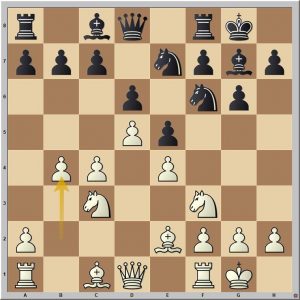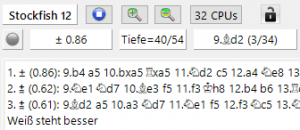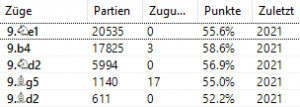Part II

1.d4 Nf6 2.c4 g6 3.Nc3 Bg7 4.e4 d6 5.Nf3 0-0 6.Be2 e5 7.0-0 Nc6 8.d5 Ne7 9.b4!
The Bayonet Attack started to get popular in the 1990s, when 9.Ne1 still was the dominating mainline. It was adopted by many strong players, which I won’t mention now, as the list would be long and the ones I forgot might feel insulted. I will just name Kramnik, being the most outstanding proponent. Here is an overview of the principal ideas it contains:
- Grabbing space on the queenside to enhance piece activity.
- Creating a weak pawn on d6 by means of c4-c5 and c5xd6.
- Undermining the pawn d6 by playing c4-c5, b4-b5, a2-a4-a5 and finally b5-b6.
- Creating a weak square on c6 by pushing the a-pawn to a6.
- Disrupting Black’s queenside structure by pushing the pawn to c6.
- Cramping Black’s pieces by pushing the pawn to c6.
- Avoiding the typical pawn storm …f7-f5-f4 and …g6-g5-g4-g3 by leaving the knight on f3 (opposed to 9.Ne1).
- Executing the maneuver Nf3-g5-e6, in order to obtain the bishop pair, the supremacy on the light squares and an annoying passed pawn on e6, while at the same time opening the position against Black’s king.
- Installing a monster knight on e4 by clearing this square with exf5 or in case Black captures on e4.
- Attacking Black’s weakened kingside after exf5 gxf5.
Let’s also sum up the meta-benefits of the Bayonet Attack:
- There is a whole variety of plans, of which many can be combined.
- Not only does this enrich the tool box, White’s flexibility also impedes Black’s ability to make predictions.
- White plays on both wings and in the center, making good use of the entire board.
- He not only steers clear of getting mated, but will be the attacker himself in many cases.
This last point is of greatest importance, as presumably most chess players feel uncomfortable when being attacked. Also important is the second aspect, which is how our opponent feels. The King’s Indian aficionado expects a high degree of activity from his opening. If we now deprive him of exactly this and force him into a passive position, he will be frustrated in all likelihood and play below his potential.
In order to accomplish this double aim, I tried very hard to avoid variations, in which the typical pawn storm …f7-f5-f4, …g6-g5-g4-g3 would occur, even if such lines were favorable for White and much more attractive than respective structures in the line 9.Ne1.
We all know that talk is cheap. So, let’s have a look at the evidence:
1. Perform a calculation with Stockfish 12 after 8…Ne7 and it will advocate 9.b4.

2. According to the Online Database, the win rate after 9.b4 amounts to a very convincing 58,6%, opposed to 56,9% after 9.Nd2 and only 55.6% after 9.Ne1.
3. Most importantly, I didn’t find a single line in which Black got away with +=. Every variation in my analysis ends with +/- or better.
Now, let me tell you about my working process, as this might affect your studies. I ordered the lines statistically, starting with the most frequent move 9…Nh5. This methodology has some benefits: It is objective and doesn’t involve judgement. It respects the player’s poll and it gives you the chance to get directly to the core of it. In general, mainlines are mainlines for a reason. They attract through quality or other criteria. 9…Nh5 appears to be the most logical move, as it combines two aggressive ideas (…f7-f5 and …Nf4). Even though it isn’t superior to most of the alternatives, it is the critical and most principled option. Always start with the most aggressive line your opponent has at his disposal. If this is done, the way is paved for the rest.
Before starting this project, my aim was to generally provide a comfortable advantage of around 0.5 pawn units, which would still be considered as “slight”. However, after a while of analyzing, my feeling for the position had improved and I realized, that the benchmark had to be lifted. “+/-” became the new paradigm and I am very glad that I managed to maintain it until the end.
This standard also influenced the length of the variations. As the author of a White-repertoire, you can usually end a variation with good conscience as soon as the position allows a +/- evaluation. However, the high quality of the Bayonet Attack turned the ending point of a normal repertoire into the starting point of the present one. The question was not, how to reach a distinct advantage, but how to transform it into tangible results. For that reason, I immersed rather deep into the lines. It is for you to decide, how far you want to follow me there. If your main goal is to safe time, you might do it up to the point, where you see enough evidence for a clear advantage from your personal point of you.

Another, rather extraordinary topic are the “+-” variations, and there are many of them. Stating “+-” is the latest point, where authors of conventional openings usually stop their analysis. I didn’t do this for two reasons. The first one is the high basis we are starting from. The second one relates to obscurity. Stockfish 12 claimed “+-” in many positions, where I wouldn’t have guessed it myself. This has to do with the closed nature of the position. The presence of pawn chains and the absence or scarcity of open lines implies that fierce interaction of the pieces, the hand-to-hand struggle, is normally postponed. The information, however, about how this fight will end is already included in the position much earlier. Sometimes, such information is difficult to decode without concrete analysis, but nevertheless, it does exist. This is similar to the fact, that all information about the limitations in which a human being will unfold is already present in every cell of a newborn baby.
Some authors are timid or vague in their style of annotation. They attach a “?!” to moves, which are obviously bad, in order to be polite and give a “+/-” in situations, where the advantage is most probably decisive. While there may be good reasons for that, my intention always was to be as precise as possible, even if this demands to be somewhat bold at times. For this reason, I tried to call out a winning advantage, whenever possible and didn’t want to hide behind a “lazy +/-“. It goes without saying, that such claims come with obligations. In the movie “Amadeus” Mozart claimed to have Salieri’s composition stored in his head after only listening to it once. So, the emperor said: “Prove it!” Basically, my task was to develop these lines until White’s advantage was highly explicit. No need for you to follow me there. You can stop way earlier and consider the rest as some kind of scientific appendix.
